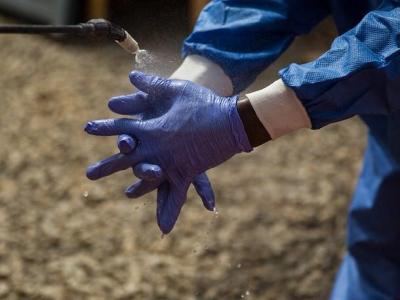Our weekly wrap-up of antimicrobial stewardship & antimicrobial resistance scans
IDSA report highlights patients' struggle with antibiotic-resistant disease
Originally published by CIDRAP News Mar 9
The Infectious Diseases Society of America (IDSA) this week published Faces of Antimicrobial Resistance, an effort to put human faces and stories to the tragic consequences of difficult-to-treat infections.
The report includes profiles of 13 patients from across the country who have struggled with antibiotic-resistant infections, including 3 of whom who died. Pathogens range from methicillin-resistant Staphylococcus aureus to multidrug-resistant tuberculosis to Clostridium difficile—including in a woman who had C diff seven times. Three of the patients have still not been cured of their antimicrobial-resistant (AMR) infections.
This Faces of Antimicrobial Resistance report highlights some of these individuals, whose stories demonstrate the urgent need to combat AMR," said IDSA President William Powderly, MD, in the foreword.
"There is no silver bullet for AMR; we need a robust, multi-faceted approach that includes infection prevention, antimicrobial stewardship, surveillance, research, innovation and an expert workforce. A combination of well-coordinated strategies will be necessary to protect patient safety and the public health and turn the tide of this crisis."
Mar 7 IDSA publication
Study: Most kids not getting first-line antibiotics for pneumonia
Originally published by CIDRAP News Mar 8
Despite guidelines that recommend amoxicillin as a first-line therapy for children with community-acquired pneumonia (CAP), most kids diagnosed with CAP are receiving macrolides and broad-spectrum antibiotics, according to a study yesterday in Pediatrics.
The retrospective cohort study included patients between the ages of 3 months and 18 years who received a diagnosis of CAP from July 2009 through June 2013 at 31 primary care pediatric practices. The investigators were looking at what types of antibiotics the patients received, and the factors associated with the choice of antibiotics.
Of the 10,414 children who met the inclusion/exclusion criteria, 40.1% received amoxicillin, 42.5% received macrolides, and 16.8% received broad-spectrum antibiotics (mainly amoxicillin-clavulanic acid). In the multivariate logistic regression model for prescription of macrolides versus amoxicillin, the factors associated with increased odds of prescription of macrolides included age ≥5 years (adjusted odds ratio [aOR]: 6.18), private insurance (aOR: 1.47), history of asthma (aOR: 1.15), and previous antibiotic exposure (aOR: 1.79). The predicted probability of a macrolide being prescribed ranged from 0.22 to 0.83 across the clinical sites.
The factors most associated with increased odds of being prescribed a broad-spectrum antibiotic versus amoxicillin included suburban practice (aOR: 7.50) and previous antibiotic exposure (aOR: 3.31). The predicted probability of a broad-spectrum antibiotic being prescribed ranged from 0.02 to 0.81 across the clinical sites.
The authors note that while age and previous antibiotic use are appropriate drivers of antibiotic use, "sociodemographic factors, including insurance status and practice location, that should not be correlated with bacterial etiology were also associated with antibiotic choice."
"Efforts to increase guideline-adherent prescribing, such as provider education and decision-support tools, should address these nonclinical drivers of prescribing patterns, including physician preferences, prescribing norms within a practice, and parental drivers of prescribing practices," the authors write.
Mar 7 Pediatrics study
Study looks at intervention to improve antibiotic prescribing at discharge
Originally published by CIDRAP News Mar 8
A new study in Infection Control and Hospital Epidemiology has found that an intervention to optimize antibiotic prescribing at hospital discharge was associated with less frequent use of broad-spectrum antibiotics and shorter post-discharge treatment durations.
In the single-center, quasi-experimental retrospective cohort study, researchers evaluated the impact of a two-step intervention at an integrated healthcare system in Denver, Colorado. The intervention consisted of (1) institutional guidance for oral step-down antibiotic selection and duration of therapy and (2) pharmacy audit of discharge prescriptions with real-time prescribing recommendations to providers. The researchers were looking at changes in the total prescribed duration of therapy and the proportion of patients prescribed broad-spectrum antibiotics (fluoroquinolones or amoxicillin-clavulanate) before the intervention (July 2012-June 2013) and during the intervention (October 2014-February 2015).
Overall, the researchers identified 300 patients from the pre-intervention period and 200 patients from the intervention period. Compared with the pre-intervention period, the proportion of patients discharged with broad-spectrum antibiotics declined during the intervention (51% pre-intervention vs. 40% during the intervention). The total prescribed duration of therapy declined from a median of 10 days pre-intervention to 9 days during the intervention, but the decline was not considered statistically significant. The reduction in duration prescribed at hospital discharge (from a median of 6 days to 5 days), however, was considered statistically significant.
In a sub-group analysis of CAP, urinary tract infection, or skin infection, discharge prescriptions for broad-spectrum antibiotics dropped even more significantly, declining from 50% to 35%. The duration prescribed at discharge dropped from a median of 6 days to 4 days.
During the intervention, there was also a nonsignificant increase in the overall appropriateness of discharge prescriptions from 52% to 66%.
The authors note that the findings are significant because previous studies have shown that infections commonly managed in the hospital, 60% to 70% of the total antibiotic course is completed after discharge. "Thus, ensuring appropriate antibiotic selection at discharge represents an important opportunity to reduce use of antibiotics with overly broad-spectrum activity," they write.
Mar 6 Infect Control Hosp Epidemiol abstract
Cochrane C difficile review favors vancomycin
Originally published by CIDRAP News Mar 7
An updated Cochrane Review on antibiotic treatment for C difficile infection (CDI) has found that vancomycin is superior to metronidazole and fidaxomicin is superior to vancomycin.
The review looked at 22 randomized controlled trials involving 3,215 patients with diarrhea who had recently received an antibiotic for an infection other than C difficile. Most of the patients enrolled in the studies had mild-to-moderate CDI, and most of the studies were active comparator studies in which vancomycin was compared to 11 other antibiotics for safety and efficacy. The primary outcomes assessed in the review were sustained symptomatic cure (defined as resolution of diarrhea and no recurrence of CDI) and bacteriologic cure.
In four of the studies, the reviewers found moderate evidence that vancomycin was superior to metronidazole for achieving sustained symptomatic cure, with 79% of vancomycin patients achieving symptomatic cure compared to 72% of metronidazole patients. Two large studies provided moderate evidence that fidaxomicin was more effective than vancomycin, with 71% of fidaxomicin patients achieving symptomatic cure compared to 61% of vancomycin patients. Two pooled studies provided low evidence that teicoplanin may be more effective than vancomycin for achieving symptomatic cure.
The only side effects attributed the antibiotics were nausea and temporary elevation of liver enzymes. Since most of the studies excluded severe CDI patients, the reviewers could not draw firm conclusions on the effectiveness of antibiotic treatment on severe CDI.
The authors note that the differences in effectiveness between these antibiotics were not large, and that metronidazole costs significantly less than either vancomycin or fidaxomicin. They recommend larger trials to determine if teicoplanin is as effective as the other antibiotics, and suggest a trial comparing metronidazole and teicoplanin—the two cheapest options.
Mar 3 Cochrane review
Chinese study finds high rates of susceptibility in UTIs
Originally published by CIDRAP News Mar 7
A study yesterday in BMC Infectious Diseases found fairly low rates of non-susceptibility in urinary tract infections (UTIs) in China from 2010 through 2014, with carbapenems and amikacin retaining the highest susceptibility rates over the study period.
Chinese researchers studied the minimum inhibitory concentrations of 12 antibiotics for 4,332 gram-negative bacilli in UTI samples from 21 hospitals in 16 cities obtained during the 5-year study period. Fully 88.5% of the isolates were Enterobacteriaceae. Of those, 63.2% were Escherichia coli and 12.2% Klebsiella pneumoniae.
The authors found that the two carbapenems tested, ertapenem and imipenem—as well as amikacin piperacillin-tazobactam—had the highest susceptibility rates again E coli, ranging from 92.5% to 98.7%. Against K pneumonia, the most potent antibiotics were imipenem (92.6% susceptibility), amikacin (89.2%), and ertapenem (87.9%).
The non-Enterobacteriaceae isolates showed lower susceptibilities to the 12 antibiotics. The researchers also noted that rates of extended-spectrum beta-lactamase (ESBL) declined slowly over the 5 years: in E coli from 68.6% to 59.1%, in K pneumoniae from 59.7 to 49.2%, and in Proteus mirabilis from 40.0 to 26.1%. ESBL rates, though, differed among the five regions of the country.
Mar 6 BMC Infect Dis study
Study makes case for 'watchful waiting' approach to kids' ear infections
Originally published by CIDRAP News Mar 6
Appropriate use of the "watchful waiting" strategy for management of acute otitis media (AOM) in children could reduce healthcare costs and improve health outcomes, according to a new study in Pediatrics.
Under current American Academy of Pediatrics (AAP) guidelines, physicians are advised to prescribe antibiotics for children 6 months or older who have severe signs of unilateral or bilateral AOM. But based on joint decision-making with parents, the guidelines also advise that clinicians can suggest observation for 48 to 72 hours before initiating antibiotic therapy if the symptoms are unilateral and non-severe. Current practice, however, appears to favor immediate antibiotic prescription for AOM, with recent data suggesting that US physicians prescribe antibiotics for AOM 95% of the time.
In the study, investigators examined the electronic medical records of 247 randomly selected patients who had been diagnosed as having AOM in the emergency department of an urban children's hospital from April 2014 through January 2015. These data were then incorporated into a decision-analytic cost-utility model of a hypothetical cohort of 1,000 children with AOM. The primary outcome was the incremental cost-effectiveness ratio (ICER) expressed in 2015 US dollars per disability-adjusted life year (DALY) averted from a societal perspective.
Of the 247 chart-reviewed patients with AOM, 231 (93.5%) were prescribed antibiotics, while 7 (2.8%) underwent watchful waiting and 9 (3.6%) were sent home without an antibiotic prescription. When the patient's records were evaluated using AAP guidelines for AOM management, 104 (42.1%) met the conditions for immediate antibiotic therapy, and 143 (57.9%) were eligible for watchful waiting. Of the patients for whom watchful waiting was an option, it was implemented only 4.9% of the time.
In the decision-analytic model, the investigators found that for every 1,000 patients with AOM, implementing watchful waiting for those who met the criteria would yield 514 fewer immediate antibiotic prescriptions and 205 fewer antibiotic courses ultimately taken, averting 14.3 DALYs and saving $5,573.
In this model, the authors write, using watchful waiting when clinically appropriate "was thus a dominant strategy, meaning it was superior to current practice by generating fewer DALYs at a lower cost."
The authors conclude that while increasing use of the watchful waiting approach would likely require more education for parents and providers, "appropriate use of the strategy could simultaneously reduce health expenditures, improve health outcomes, and be cost-saving to society."
Mar 3 Pediatrics study
Higher risk of mortality, costs for community-onset C difficile patients
Originally published by CIDRAP News Mar 6
Community-onset C difficile infection (CDI) is associated with increased risk of all-cause mortality and short- and long-term economic costs, according to a new study in PLoS One.
For the study, researchers estimated the attributable mortality and costs of community-onset CDI by conducting a population-based matched cohort study in which 7, 950 community-onset CDI patients identified in Ontario from 2003 through 2010 were matched with randomly selected uninfected subjects and followed through 2011. The investigators examined 30-day, 180-day, and 1-year all-cause mortality and evaluated the costs of publicly funded healthcare services. Costs were calculated in Canadian dollars.
The researchers found that patients with community-onset CDI had considerably higher risk of all-cause mortality and higher costs compared with uninfected patients. The relative risk for 30-day, 180-day, and 1-year mortality were 7.32, 3.55, and 2.59, respectively, and the cumulative 30-day, 180-day, and 1-year costs were $10,700, $12,517, and $13,312, respectively. In the stratified analyses, hospitalizations and physician visits accounted for the largest cost components across all phases.
"Our estimates of absolute and relative mortality and costs highlight the need for interventions to prevent community-onset CDI," the authors write.
Mar 3 PLoS One study









